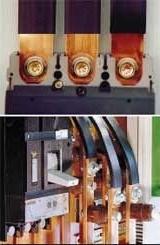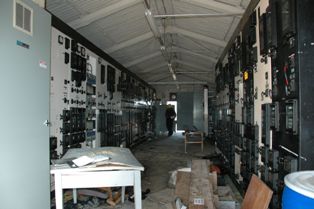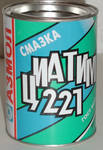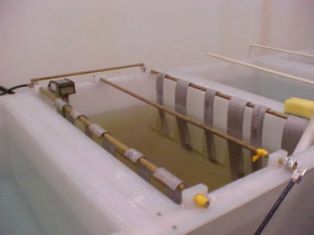Protective coatings and lubricants for electrical contacts
Corrosion of metals in electrical contact is a complex process that combines purely chemical interactions of metals with the environment and electrochemical phenomena occurring in the contact zone between different metals. In order to protect them from corrosion, the metal parts of the electrical contacts are made with special non-metallic or metallic anti-corrosion protective coatings.
Electrical contacts in closed electrical installations with a normal environment are usually made without special protective coatings.
Protective coatings against corrosion under these conditions naturally form films of oxides on the surfaces of the wires to be connected as a result of the action of oxygen in the air on them.
In closed electrical installations with an aggressive environment, depending on the degree of aggressiveness and humidity, as well as in outdoor installations, parts of electrical contacts are covered with special non-metallic or metallic protective films.
Non-metallic anti-corrosion coatings

Passivation and oxidation of contact parts made of steel, copper and aluminum is carried out by treating them in aqueous solutions of alkalis and salts or by immersing parts in concentrated solutions of acids, for example nitric or chromic acid.
The solutions are placed in special stationary steel tubs, into which the workpieces are loaded, hanging on the holding rods. The process of processing parts is carried out by heating solutions to a temperature of 50 — 150 ° C and lasts 30 — 90 minutes with the release of harmful fumes. As a result, the bathrooms are equipped with heaters and ventilation devices.
Blow molding is mainly used to process steel contact parts (bolts, nuts and washers). To do this, the parts are heated in furnaces or ovens to a blue glow and, while heated, are immersed for 1 — 2 minutes in a bath filled with linseed oil. The parts are then removed from the bath and laid out on a rack, allowing the excess oil to drain from them, and to dry and cool.
Metal anti-corrosion coatings
Metal anti-corrosion coatings involve covering the contact surfaces of the connecting parts with a thin layer of another metal, such as cadmium, copper, nickel, tin, silver, chromium, zinc, etc. The application of metal protective coatings is carried out by galvanization, metallization or hot methods.
Galvanic An electrolytic method of applying a layer of another metal to the surface of steel and copper parts of electrical contacts. It is carried out in baths with galvanic electrolysis filled with electrolyte, passing through it a direct current obtained from rectifiers at voltages of 6, 9, 12 V.
The electrolyte is aqueous solutions or molten metal salts. Depending on the composition of the electrolyte, cadmium plating, copper plating, nickel plating, tin plating or tin plating, silver plating, chromium plating and zinc plating are carried out electrolytically.
The electrolysis process is accompanied by the release of harmful gases and vapors, which is why rooms with electrolysis baths are equipped with supply and exhaust ventilation.
At the end of the electrolytic process, the parts are transferred to hot and cold water rinse baths and, after thorough rinsing, dried with compressed air.
Bath with galvanic electrolysis
Metallization — a method of applying a thin layer of pre-melted other metal to the surface of contact parts by spraying with a jet of compressed air.
Cadmium, copper, nickel, tin and zinc are used for metallization. Preliminary melting of metals is carried out in crucibles or in a flame of combustible gas or an electric arc on special devices, and their application to parts is carried out by spraying using special spray guns.
Hot plating is carried out by immersing the contact parts in a bath of molten metal with a low melting point, for example, cadmium, tin and its alloys, lead, zinc and various solders. Preliminary melting of metals is carried out in electric crucibles or in the flame of gas apparatus and blowtorches.
This method is especially widely used in assembly conditions for tinning of copper and steel contact surfaces and parts with different solders. To do this, the processed contact surfaces, previously lubricated with a solution of zinc chloride (soldering acid), are immersed in a bath of molten solder, then quickly removed from the bath, washed in water and wiped with a dry cloth.
Tinning of contact surfaces can also be done by manually applying a thin layer of solder melted in the flame of a gas torch or blowtorch, using acid-free fluids. The quality of applied protective coatings depends on the pre- and post-treatment of the contact parts. The main condition for obtaining durable and non-porous protective coatings is the cleanliness of the surface of the metal to be coated.
Methods for cleaning electrical contacts
Preliminary cleaning of the contact surfaces and parts is carried out depending on the degree of contamination and production possibilities by means of mechanical, chemical or electrochemical treatment.
A mechanical method of cleaning electrical contacts consists of processing surfaces on abrasive machines with metal brushes, sandblasting or manual processing. Small parts (washers and nuts) are usually machined in rotating drums using abrasive and sanding powders.
After mechanical cleaning, the contact surfaces and parts are degreased, that is, the existing grease and other contaminants are removed from them.
Degreasing is carried out chemically by washing the parts with petrol, kerosene, benzene and other organic solvents or etching them in solutions of acids, acid salts and bases.The parts are washed and engraved in special baths and apparatus.
The chemical cleaning process lasts from 5 to 90 minutes, while solutions heated to 70 — 95 ° C are used for etching. The carved parts are rinsed from the remains of the solutions first in hot, and then in cold soda and dried.
Complete and high-quality preliminary cleaning and degreasing of the contact parts with the subsequent application of anti-corrosion protective coatings on them ensure tight adhesion of the films to the base metal and exclude the formation of defective delamination on them.
Metal protective coatings on contact surfaces are also applied by the cladding method, by hot rolling a package consisting of a plate of a base metal, such as aluminum, with thin sheets of another metal, such as copper, superimposed on it on one or both sides.
It is recommended that cadmium or tin-zinc protective coatings be applied to copper release connectors, zinc, cadmium, copper plating, tinning or blueing of steel parts, and copper clad or reinforced aluminum surfaces.
Most of the accepted methods for applying protective coatings on metals, especially metals, require special and complex stationary technological equipment for their implementation.

In the detachable joints of aluminum conductors with aluminum, copper and steel conductors of electrical equipment, the contact aluminum surfaces, due to their active oxidation, undergo additional preparation immediately before connection.
This preparation consists of mechanical processing and removal of the aluminum contact surface from the oxide film. In this case, the surface is cleaned under a layer of technical petroleum jelly, followed by application to the treated surface. a protective grease or paste that prevents oxidation of metals.
Lubricants and pastes must have high stickiness (adhesion) and be applied to the surface in a thin layer, have elasticity and not crack from temperature fluctuations in the range from -60 to + 150 ° C. They must have a high point of release within 120 — 150 ° C, be chemically stable, except for fat or paste degeneration, moisture-resistant and resistant to acids and bases. Violation of coverage in at least one place leads to formation of metal corrosionwhich tends to eat into metal.
In addition, at the point of contact between the lubricant and the paste, they must ensure the destruction of the oxide film chemically and prevent its reappearance for a long time.
Technical petroleum jelly — a low-melting hydrocarbon grease in the form of a homogeneous ointment, without lumps, light or dark brown in color. Drop point not lower than 54 OS.
Technical petroleum jelly is used to protect metal parts from corrosion. When the temperature rises above + 45 ° C, this does not guarantee the retention of a sufficient amount of grease in the contact of the joint. It has increased neutrality with respect to the formed oxide film. In the electrical installation industry petroleum jelly is widely used as a protective lubricant against corrosion in all cases where it is necessary.
 Grease CIATIM — universal, fire-resistant, moisture-resistant, frost-resistant, activated, without mechanical impurities, homogeneous ointment of light or dark yellow color. The drop point is not lower than 170 °C.
Grease CIATIM — universal, fire-resistant, moisture-resistant, frost-resistant, activated, without mechanical impurities, homogeneous ointment of light or dark yellow color. The drop point is not lower than 170 °C.
CIATIM is used for lubrication and protection against the harmful effects of the atmosphere at high and low temperatures. With a significant mechanical impact on the lubricant, its dynamic viscosity decreases, as well as the ultimate strength, and the lubricant acquires increased fluidity. CIATIM grease has increased chemical stability and, in terms of its properties, is more suitable for use in contact joints than other greases.
Protective pastes of zinc-vaseline and quartz-vaseline are a mixture of technical petroleum jelly (50%) with zinc dust or quartz sand (50%). Pastes have the ability to destroy the oxide film when assembling contacts using finely crushed solid fillers (zinc or sand dust) introduced into technical petroleum jelly.

